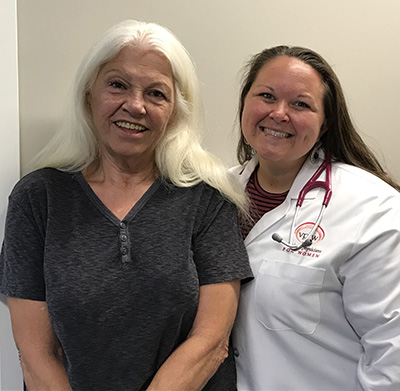Lauren Cook, N.P., discusses the gynecologic challenges women face as their bodies produce less estrogen later in life
When you think of common health concerns among women 65 and older, what comes to mind? Osteoporosis, breast cancer, diabetes, and hypertension are commonly known challenges faced by older women…but there is so much more than that. At VPFW, we provide mammography, bone density scans, and screenings for those commonly thought of post-menopausal issues. But we’re also able to treat gynecological problems that don’t often come up in conversation among senior women.

Many women assume that once they enter menopause and are no longer able to carry babies, their need for an OB/GYN diminishes. In fact, the exact opposite is true. Women 65 and older often find themselves needing to spend more time at their gynecology office – aside from their routine screening exams. Menopause marks the end of menses and the challenges that come with it; but on the flip side, it marks the beginning of a new phase of life – and new potential problems. This is an area of gynecology I am passionate about, so I’d like to talk you through some of the changes and challenges that often follow menopause.
Decreased estrogen causes new challenges in a new phase of life.
Estrogen plays a major role in the overall health and wellness of a woman’s body. From puberty until menopause, estrogen helps with regulation of menstruation, monthly ovulation, lactation after pregnancy, and even keeping mood swings in check. However, after menopause, a women’s ovaries do not produce nearly as much estrogen or other hormones. This decrease in estrogen levels can lead to several gynecological challenges for older women. In fact, most women 65 and older will likely experience some ill-effects from estrogen deficiency.
What are some of these challenges, and are they normal?
Challenges such as vaginal atrophy, chronic urinary tract infections, urinary incontinence, pelvic organ prolapse, and postmenopausal bleeding most often occur after menopause, in part due to an estrogen deficiency. They can have a major impact on a woman’s wellbeing.
Women often associate these issues with getting older, thinking it is “normal” to experience them once you reach a certain age. But just because these issues are common does not mean they are normal, or that you are doomed to suffer because you are aging. Your women’s health provider can help you find management methods to achieve and maintain a better quality of life. Let’s talk through some of the most common post-menopausal challenges women face but often hesitate to bring up with their provider.
Vaginal Atrophy
After menopause, the vaginal walls can become thin, dry, and inflamed. This is called vaginal atrophy. This change in vaginal tissue occurs as a direct result of estrogen deficiency combined with the effects of aging. Vaginal atrophy can affect women in different ways. A woman with vaginal atrophy can often experience chronic burning, itching, inflammation, painful intercourse, recurrent urinary tract infections, and/or urinary incontinence. Vaginal atrophy and the issues that come with it can be managed in a variety of ways. There are both hormonal and non-hormonal management options for patients, and your women’s health provider can determine what is most appropriate to suit your needs.
Urinary Incontinence
Imagine every time you cough, sneeze, laugh, or jump … you leak urine. While incontinence is not normal, it is a reality for many women, especially later in life. It is estimated that up to 30% of women age 65 and older suffer from urinary incontinence and that 50% of all women who reside in a nursing home have some form of urinary incontinence.
There are a few age-related changes in the female body that put older women at a greater risk for developing incontinence than older men. A diminishing estrogen supply, weakening of the detrusor muscle (a muscle inside the wall of the bladder), and pelvic organ prolapse (see below) are among the age-related causes of incontinence in women. Aside from the physical changes mentioned, there can also be age-related transient causes such as a medication, constipation, limited mobility, confusion/delirium, and chronic urinary tract infections. There are also many treatment options for urinary incontinence. Our two highly experienced urogynecologists at The Urogynecology Center at VPFW can help you find the best solution to provide you with relief.
Pelvic Organ Prolapse
Where there is urinary incontinence, there is also likely to be a weakened pelvic floor and often prolapse too. Prolapse is a disorder where damaged or weakened muscles or tissue in the pelvic floor cause pelvic organs to drop from their normal positions. Often this damage is the result of pregnancy or childbirth. Symptoms of prolapse include feelings of pressure, discomfort, aching or fullness in the pelvic floor that often worsen as the day goes on. Sometimes patients can even see a bulge coming out of the vagina. The uterus, bladder, and rectum are the three most common of the pelvic floor organs to potentially prolapse.
What puts you at increased risk for experiencing a pelvic organ prolapse?
- Estrogen deficiency during and after menopause can cause decreased turgor and tissue elasticity which can aid in weakening/stretching of the pelvic floor.
- Vaginal delivery can strain and eventually stretch the connective tissue of the pelvic floor. The risk increases with multiple deliveries or a baby weighing more than eight pounds.
- Obesity puts pressure on your abdomen which can lead to a weakened pelvic floor.
- Straining to have a bowel movement can weaken the pelvic floor.
- Frequent coughing can put a strain on your pelvic floor.
- Aging can also cause prolapse. The highest affected population of pelvic prolapse are women 80 years and older. Approximately 37% of all pelvic floor disorders are women between the ages of 60-79, and roughly 50% are over the age of 80.
Unfortunately, women often ignore the symptoms of prolapse due to embarrassment or fear. But there are several ways your provider can help mitigate the problem. Physical therapy, pessary devices, and surgical intervention are the three most common ways your women’s health provider can treat pelvic organ prolapse. This is another area where our expert urogynecologists can help determine the best solution.
Do not suffer in silence.
While the gynecologic challenges women encounter after menopause are common, women shouldn’t see them as the new normal. There are many options to ensure an all-around quality of life; however, your women’s health provider won’t be able to help you find a solution if they don’t know you’re suffering. Our goal as providers is to make you feel comfortable and confident in talking to us about your struggles so that we can help you find treatment options that meet your individual needs. With everything women’s bodies endure throughout their lives, women deserve to live their golden years in comfort. We strive to help you get there.
To make an appointment with an OB/GYN provider at one of our Richmond, VA, locations, call VPFW at 804-897-2100 or message us to schedule online.
